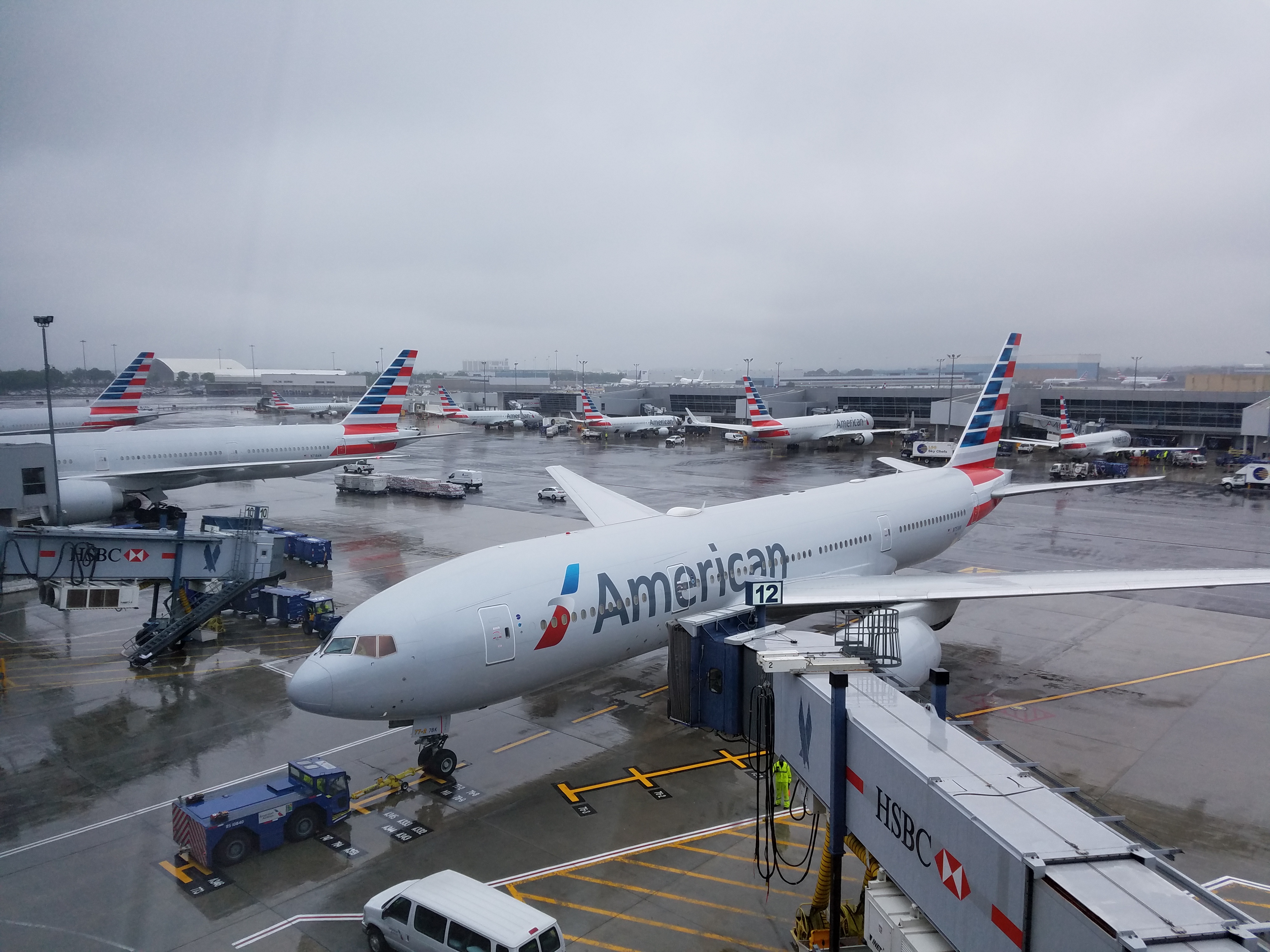During earnings calls a lot of assertions get made that go unchallenged. They may not stand up to scrutiny but they get repeated because if an airline executive said it, it must be true.
American’s call on Friday included one whopper and one claim I’ve been trying to make sense of. (HT: David F. on the latter claim).
American Claims They’re Making More Money Off Premium Cabins
First the claim I’ve been working to understand, from President Robert Isom.
In domestic, our consolidated PRASM was up 5.7%. We saw strength across the board with Philadelphia and Miami leading the way with double digit increases. We continue to implement a number of revenue management initiatives for the Premium cabin and these are proving to be very effective. Our sales initiatives with our high-value channels are also gaining momentum as we continued to see strong performance with gains in corporate share, share gap and average ticket values.

We know that Miami performance improved because Latin America is improving overall. However the claim that “revenue management initiatives for the Premium cabin and these are proving to be very effective” seemed strange.
This is distinguished from the introduction of a new international premium economy cabin which is discussed elsewhere, so that’s not where the revenue is coming from. Upgrades and awards in American’s international business class were already tough to come by, it doesn’t seem like they would be earning more money by avoiding giving away seats cheap.
Domestically first class is being sold at a somewhat higher premium over coach than it was two years ago, but this isn’t a change over the past several months and doesn’t seem as though it ought to be characterized as ‘very effective’ in terms of the incremental revenue it’s driving.
What is new this year is that advance upgrade inventory has mostly disappeared. American used to allow any AAdvantage member to spend miles and cash to upgrade nearly any domestic flight outside of their premium cross country routes. Now that upgrade space is rarely available.
However this actually makes upgrades easier. General members earning miles on a credit card aren’t taking up upgrades, and more upgrades then are redistributed to top elites who receive them complimentary. The loss of the cash co-pay would be revenue-negative.
Meanwhile it’s tough to argue that upgraders were taking up all the seats up front and that customers couldn’t buy first class seats before (if that situation had actually existed then holding back seats could be revenue positive, but that’s simply not the case).
So how could their premium cabin revenue initiatives be driving substantial incremental revenue?
Let’s Just Pretend Changes to AAdvantage Earn American More Money
Derek Kerr, American’s Executive Vice President and Chief Financial Officer, throws out there that changes the airline has made to the AAdvantage program — changes which reduce its differentiation from United and Delta and no longer give customers a reason to choose American over its competitors — is a driver of higher revenue.
Our significant investments in our people, product, and new corporate sales initiatives are paying off, and when coupled with our new revenue management tools, changes to our AAdvantage program, and our new mobile platform, the results have been impressive.

Granted the claim here isn’t very specific, it’s more bundled into a list, and heaped into the same category as American’s mobile platform as a driver of airline performance it’s clear how much credibility should be afforded the claim. You cannot even buy a ticket inside of American’s mobile app.
Changes to the AAdvantage program are cost savers — fewer international upgrade certificates, more miles required for awards, fewer miles awarded for travel. These changes aren’t contributing to revenue.
In fact, American’s new credit card deal was supposed to make more money for the airline simply by virtue of banks paying American more for miles and benefits. This didn’t require customers to like AAdvantage more or want to accumulate miles more than before. As Kerr explained in the call, “the increase in the new credit card deal that we did was more rate driven than it was volume driven.”
And yet American told the SEC they weren’t making as much off the deal as expected. Volume was down.
And since that filing three months ago we’ve seen the biggest signup bonuses ever publicly offered on American’s co-brand credit cards. They wouldn’t be spending more than ever to acquire card customers if they didn’t need to. Changes to the program appear to be dampening interest, not driving revenue and American and its co-brand issuing partners need to spend more to make up for this.
Just because a claim is made in an earnings call doesn’t make it true.


I don’t trust American to tell the truth. I am negative on flying right now anyway with increased TSA’s useless intrusiveness. De-motivating pricing that doesn’t allow luggage on Delta. Virgin sold to Alaska. Major impacts on my motivation to fly.
If you read the transcript (now widely available on the wire services), you’ll see that the big premium cabin boost is transatlantic. Business up front is very good there. AA claims their improvements have something to do with it, and they’re probably right, but I suspect the big improvement is demand. Have you seen the stock market lately? Businesses are doing well, do business travel is doing well.
The most interesting number is that transatlantic unit revenue is essentially flat even though everyone (including AA) acknowledges that coach pricing is VERY weak across the Atlantic. It’s weak because of the Norwegians of the world are flooding the Atlantic with below cost fares. But the strong business class demand means AA can easily manage the big decline in coach fares. The company who cannot manage these low coach fares is Norwegian, which doesn’t have the business travelers to offset the weakness in economy pricing. So I think it’s pretty easy to predict what’s going to happen to Norwegian, and we’re already getting lots of media reports of their financial woes. The failure of the ultra low cost model across the Atlantic will probably be the top aviation story of the next year.
Changes to the AAdvantage program may not affect cash flows but I believe he could be a truthful statement in the sense it is affecting accounting revenue if they are deferring less as they are granting less miles (which also have less value each year) and upgrade instruments etc, enabling them to recognize a higher proportion of revenue when the traveler flies on the ticketed flight.
Great analytical work Gary, to the extent that AA attributes revenue growth as being due to their own initiatives vs just a strong economy and cheap oil (for the time being) I bet you are right on the money. Certainly I see no reason to go out of my way to earn AA miles anymore, the award availability went from bad to atrocious. Thank you for covering this.
Very interesting article. It appears to me that increased premiums on business seat travel would be more significantly cyclical than worldwide traffic or credit card partner earnings. If so, then American Airline earnings are volatile. Any hiccup in the economy, would have a magnified effect on American Airlines earnings. Since it is increasing difficult to tell the difference in the model of Delta, American Airlines, or United, it would probably have a similar effect all three airlines. Just desserts?
I just used 180,000 of my remaining 265,000 AA miles to book one ways to Europe and Mexico in 2018. When my remaining miles are used, I’m done jumping through AAs ever changing hoops. I was already disgusted with having to find ways of avoiding their “One World” partner British Airway’s exorbitant fees for return travel from Europe. Now they’ve removed any way to avoid getting my pocket picked. So I really don’t care about the technical details of all they’re doing with their new revenue based model, yada yada. I just care that it’s clear they don’t give a hang about any customers that don’t spend well into five figures annually for air travel. Understood, AA. Got it.
Gary stick to what you do best like focusing on what flavor sundae is served on which route or which gulf carrier has your favorite booze. You have no clue about AA and it shows.
Best part is once the banks wise up and stop your gravy train you will fly back of the bus, pay baggage fees, sit in middle seats while the leadership on seventh floor of HDQ 1 have lifetime A5 passes and will be laughing their way to the bank!
Did you read the WSJ on chase sapphire high acquisition costs for low value bonus chasing fodder?
@Josh G – “Did you read the WSJ on chase sapphire high acquisition costs for low value bonus chasing fodder?” I wrote about the Wall Street Journal article, but it sounds themes similar to what I’ve argued here on the blog.
“You have no clue about AA and it shows.” Funny, you do not say a single thing that is specifically wrong or that you disagree with in this post.
Of course you never do, cause you got nothing. Ad hominem is the last refuge of small minds.
I’ve written an article myself on this – I think the answer is overbooking. As part of the transatlantic JBA, British Airways have mandated that AA start overbooking their premium cabins.
https://gingertravelguru.com/2017/07/31/american-airlines-premium-revenue-increase/